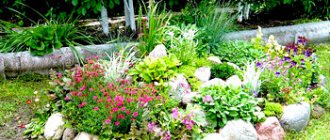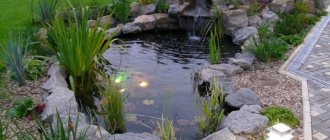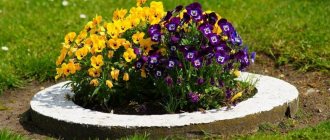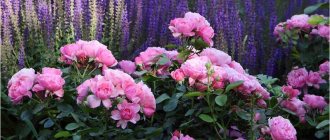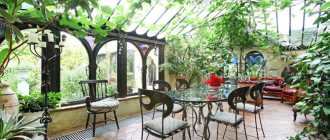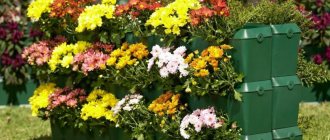How to choose the optimal place for arranging an alpine slide?
First of all, you need to choose a suitable place for future alpine slides at your dacha with your own hands, photos of which can be viewed on the website. The best solution may be to choose a site on the southwest or south side. A good option is a place on a slope where low-growing crops can be planted among the stones.
The place under the stone structure should be well lit and accessible for viewing
The basis for a small area can be a slope along the border of the territory or even along the edge of the terrace. When choosing a space for a slide, you should consider the following factors:
- the slide must be visible from all sides, so this place must be open;
- the structure should be placed in a sunny and bright area where there are no tall trees;
- the structure is placed in a place isolated from the wind.
Trees should not rise above the structure and the wind should not blow
Helpful information! When starting to build a structure, it is worth considering a suitable design style. Various landscape solutions involve the use of rocky gardens, ponds or bridges, which should be combined with a slide.
Choosing suitable stones
The size of future elements of the slide should correspond to the size of the garden plot; elements that are too large will be inappropriate, and too small ones will not be noticeable on a large plot. Boulders must be selected in accordance with the scale of the site. Large stone sizes are suitable for spacious areas, but if the area is not very large, it is better to choose medium-sized boulders or even flagstone.
The texture of the stones should not be pretentious, but they should emphasize the overall design of the area and the chosen type of vegetation
When trying to make the most beautiful creation, it is important not to overdo it, naturalness and naturalness are very important for such a creation. Therefore, it is better to choose stones from granite; it can be any other natural stone.
What time of year is suitable for creating a flower garden?
The work performed to install the slide practically does not depend on the time of year. It is not recommended to start work in winter. The best period is considered to be autumn, when there is time before cleaning the area for the winter. A rocky structure after installation requires time for a certain shrinkage. After this, you can only start planting plants. If the plants are planted in the fall, then the construction of the main structure can begin in the spring. A high-quality alpine slide is created with your own hands using step-by-step photos and diagrams.
The best time period for planting mountain crops is autumn
Finishing a mini rock garden after planting
It begins after planting the plants. All spaces between the stones are mulched with the same stones, only smaller in size. If possible, keep the layers parallel or use stone chips of the same type as the main stone. The soil should not be visible at all. Mulch will help retain the soil moisture the plants need and give the composition a more natural look of a rocky mini-landscape.
Features and rules when performing rock gardens
A rock garden is a stylish decoration for a dacha area. To decorate it, perennial plants are selected that have different flowering periods.
The rock garden project must be carefully planned and drawn on paper
When creating an alpine structure, you should follow the following tips:
- the structure is erected according to the project, which indicates the number of tiers and the placement of stones;
- a certain type of stones and their placement are selected;
- flowers are selected taking into account their blooming time, microclimate and color palette.
For your information! The Alpine Hill is a small model of a real massif with undulating transitions from a rocky peak to flatter areas. It is important to respect the style of the structure, the size of its tiers, as well as the recreation of all conditions for mountain plants.
It is important to choose the right plants
Related article:
Plants for alpine hills: photos and names. A separate publication presents the most popular types of coniferous and deciduous plants for rock gardens with photo examples.
Video description
The best ideas for creating alpine slides in the video:
The final stage is the selection and planting of plants. An important condition is that plants should be chosen perennial and frost-resistant. Planting should be done in a chaotic manner so that the mini-rock garden looks natural. Plants can be anything (dwarf willows, sedum, young, alpine carnation, succulents and many others).
A miniature rock garden also requires special care. It consists of constant watering and removal of wilted leaves and plants. If weeds appear, they must be carefully removed and a layer of substrate added. In winter, it is best to place the rock garden in a dry and windless place.
Do-it-yourself Alpine slide: step-by-step photos, diagrams and construction features
Before starting work, landscape design is thought through. Do-it-yourself Alpine slides, photos of which can be seen in the photo gallery, require a special approach and a well-planned project. When choosing a suitable site for construction, the proximity of groundwater passage is important. If they are located close together, the strength and durability of the structure is threatened. The groundwater level is influenced by special drainage.
A well-thought-out project will help during installation work
Soil and drainage preparation
To make a beautiful alpine slide with your own hands, step-by-step photo instructions and diagrams will help you complete the installation.
Marking the contour and digging a trench for laying stones
The stability of the structure depends on the quality of the drainage system
First of all, the drainage system is performed:
- To do this, a pit is dug larger than the site;
- Before this stage, the terrain is marked, which is done using a coil of wire and special wedges;
- the height of the trench should not be less than 0.9 meters;
- the created depression is filled with crushed stone;
- the resulting layer is filled with water;
- then a sand and gravel composition is laid, which is compacted;
- the extracted layer of soil is cleaned and added on top of the constructed structure.
Stone laying can begin after the structure has settled. This may take about four months.
Helpful advice! You can add crushed stone to garden soil, and add sand to clay soil.
The drainage system diagram includes several layers
How to place the stones?
An alpine slide is made from stones with your own hands. Step-by-step photos, diagrams and drawings will help you choose the best design project. Before laying the stones, it is worth preparing a special mixture. In this case, coarse sand, loam from the garden and compost are used. Crushed gravel is also used.
The method of laying the stones depends on the type of project planned
A similar composition can be distributed over the drainage. After this, the mixture is moistened and trampled. Large stones are installed first, and then smaller ones. When constructing, you should use the following recommendations:
- layers of stones should be laid parallel;
- the upper stones must be installed on the lower blocks, but not on the soil, as this will cause the sculpture to skew;
- if you plan to plant plants with a powerful root system, then you should leave space between the blocks for them;
- voids should be filled with soil.
The use of stones of various sizes should be combined with the plants being planted
The stones must be laid so that the soil between them does not erode during heavy rainfall. Sandstones, limestones and basalt with granite are used in the construction of this structure. Experts do not recommend using shell rock or tuff.
Helpful information! To retain moisture for plants, the surface of the rock garden can be sprinkled with gravel or stone chips.
Compacting the soil is a mandatory step before laying stones
Creating compositions with large boulders will require help
Video: DIY rock garden construction
Choosing a container for a rock garden
The material from which the container or trough is made plays a very important role in our climate . It must be frost-resistant to withstand our harsh winters. There must be drainage holes at the bottom. Stone troughs are ideal.
Stone mini rock gardens
How to make troughs for a mini rock garden yourself?
If you can’t get them, you can make containers yourself, using as a basis a mixture of equal parts of peat, sand and cement, or use metal containers. It's a matter of opportunity and preference. In urban gardening in Tallinn, containers that are resistant to winter temperature changes are very popular. They are produced in factories using concrete. The outer surface is often decorated with natural stones. For my garden, I chose these containers measuring 850x400 mm and height 270 mm.
Ready-made troughs for mini rock gardens can be purchased in European stores
Drainage in a mini rock garden
They are placed on the bottom of the containers after they are installed in a permanent place, having previously covered the drainage holes with broken shards from old ceramic pots. The drainage layer is 1/3 of the height of the container. Drainage is needed so that water can easily and quickly leave the container without stagnating in it.
Substrate for mini rock garden
Garden soil, peat, drainage materials (coarse sand and stone chips) in a ratio of 1:1:2.
Containers are filled to the brim with this substrate and poured well so that all voids are filled. Add substrate if necessary.
Stones for mini rock garden
Will be needed for a design in the style of a Czech rolling pin. In modeling a miniature mountain landscape, stone plays a priority role. To do this, choose stones that match the color of the container so that they complement each other. It is desirable that they be flat - such stones are easy to work with, they, like parts of a construction set, are assembled into a single whole. All layers are laid strictly parallel. The same substrate is poured into the narrow gaps formed, leaving small holes for planting.
Mini rock garden with geraniums and sedums
Choosing plants for a mini rock garden
It is a creative process, sometimes involving trial and error. There are plants that can grow and overwinter in our climate and in containers, but they need to be selected very carefully.
The first requirement: they should not freeze out in severe frosts, even in snowless winters. Plants native to the tundra and high mountain regions are suitable, preferably from altitudes above 4000 m above sea level. There they were able to adapt to harsh living conditions: strong winds, low temperatures, freezing of roots.
Mini rock garden with juveniles
The second requirement is that they grow slowly and remain compact. These are dwarf willows, breakers, krupki, mountain primroses, gentians, saxifrages and other plants. Despite their small size, during flowering they will become a real decoration of a mini rock garden. Also, the conditions of a container rock garden are well tolerated by conifers: miniature varieties of common spruce, prickly spruce, and Canadian hemlock, which have minimal annual growth.
Do-it-yourself Alpine slides at the dacha: photos of the best compositions
Mountain structures can be used in various variations. Based on the photo, you can choose the most interesting options:
- the composition of a valley in the highlands reflects the appearance of a high plateau, with large stones buried two-thirds into the soil and complemented by bushes of different heights and winding paths;
The valley requires the use of a large number of stones of the same type
- large blocks are required when creating a rock cliff, in this case dwarf fern, mountain pine and juniper are planted;
The rock composition is made using natural hills
- if there is a slope, you can arrange a mountain slope, which is formed using dwarf pines and heather;
If you are not satisfied with the uneven landscape, then you can disguise it with a similar composition
- the composition in the form of a gorge is characterized by complexity, while a landscape of different heights is used and the hillocks are lined with boulders;
To implement such an idea will require a large amount of time and materials.
- when constructing a ravine in a forest, fontanel and perennial plants are suitable;
A small ravine will allow you to construct a unique and natural composition
- if the area is constantly moist, then you can use a swamp composition, which is formed using a pond;
A small pond will add originality to landscape design
- An original solution is considered to be a cascading stream, along the banks of which primroses, ferns and irises are planted.
Water flowing in cascades can decorate any recreation area
Helpful information! The classic solution is a centric structure, in which bright plant flowers are combined with rocky elements. The basis is an area with natural elevation.
Useful tips
Do-it-yourself Alpine slide: step-by-step photo, the diagrams of which are presented in this review, can be built using the following recommendations:
- the humped area is ideal for creating an unusual design;
- if cement is not used during construction, the structure can be reconstructed in the future;
- suitable height from 0.5 to 1.5 meters;
- limestone or sandstone is suitable for plants;
- It’s worth considering additional lighting.
Uneven terrain is an excellent opportunity to implement original design solutions
Plants can transform an area beyond recognition
Illumination at night allows you to create a fabulous place from an ordinary rock garden
With the help of a pond you can decorate any rock garden. Compliance with all the rules will allow you to create a stylish and original structure that will last for many years.
When creating a rock garden, all elements must be combined: lighting, stones, plants and adjacent paths
Rock garden care
Work on caring for the rock garden should be carried out after planting. It may seem that the plants of stone gardens are unpretentious, but this is far from the case. It is recommended to monitor the plants every day, add soil as it settles, and loosen the top layer. It is necessary to water the plants abundantly, especially in the first days after planting. Over time, weeds may appear in the rock garden.
It is necessary to weed the alpine hills and prevent them from blooming. In the summer, the condition of each plant is monitored, since during this period many diseases spread and pests begin to appear. Viral diseases are very dangerous for plants. Recently, viruses have spread to almost all plants. Signs of the disease are clearly visible on the leaves: they become deformed and become curled.
Signs of the disease are also noticeable on flowers - the flowers acquire a greenish tint or become barren. The main carriers of the disease are aphids and moths. Plant protection against viruses means the destruction of disease carriers, as well as adherence to general hygiene rules. A reliable way to combat pests is timely plant protection measures. If the pest has already settled on the plant, the diseased organ should be removed; sometimes it is necessary to remove the entire plant.
High mountain plants require special care on alpine hills in summer. They must be constantly irrigated, thereby ensuring a high level of humidity. Species that died during the season are replaced by replanting plants from a reserve site organized in the spring. Bulbs are planted in the fall; It is necessary to have time to carry out planting work before October, in which case the bulbs will take root well in the soil.
Rock garden. Polimerek

